 ”Deal of Century” (DoC) aka ”Trump peace plan” – a long waited Mideast peace plan by the White House – has now been released as its full format. Officially known as ”Peace to Prosperity: A Vision to Improve the Lives of the Palestinian and Israeli People, is a proposal to resolve the Israeli–Palestinian conflict. Earlier in late June 2019 the economic portion was made for public as the first part of Deal in the Bahrain Conference.
”Deal of Century” (DoC) aka ”Trump peace plan” – a long waited Mideast peace plan by the White House – has now been released as its full format. Officially known as ”Peace to Prosperity: A Vision to Improve the Lives of the Palestinian and Israeli People, is a proposal to resolve the Israeli–Palestinian conflict. Earlier in late June 2019 the economic portion was made for public as the first part of Deal in the Bahrain Conference.
DoC – this “out of the box” plan made by by the Trump administration – is rather a reaction to political realities in MidEast; it is the United States’ redefinition of the parameters for definitively resolving the Israeli-Palestinian conflict in large part espoused Israeli positions. One can describe DoC as an updated version to sc ”Clinton parameters” – created during Oslo process – which were the framework some two decades for negotiations between Israel and Palestinian authority.
DoC aka ”Trump peace plan”
[An improved economic situation was]“a necessary precondition to resolving what was previously an unsolvable political situation,” (Jared Kushner)
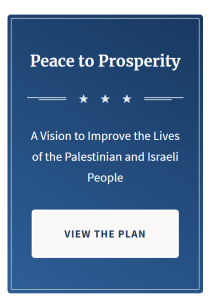
The plan, outlined in a 180 page report, calls for a two-state solution (Israel and a future Palestine) with Israel retaining all of its current West Bank settlements, all of Jerusalem including the holy sites, and security control over the entire West Bank. The capital of the Palestinian state will be in “eastern Jerusalem,” in neighbourhoods beyond Israel’s security barrier.
The plan speaks about an innovative network of roads, bridges and tunnels that enable freedom of movement. The tunnels will be state-of-the-art, according to the plan. It will include tunnels or a covered road that might link Gaza and the West Bank, according to the map.a 34-km. tunnel or covered overpass that links the West Bank to Gaza.
The plan’s map seems to show the Palestinian state extending to large enclaves in Israel’s Negev that will be larger than Gaza itself.
Here are some of the key points, as outlined by the White House:
- The Vision provides for a demilitarized Palestinian state living peacefully alongside Israel, with Israel retaining security responsibility west of the Jordan River.
- Over time, the Palestinians will work with United States and Israel to assume more security responsibility as Israel reduces its security footprint.
- Approximately 97% of Israelis in the West Bank will be incorporated into contiguous Israeli territory, and approximately 97% of Palestinians in the West Bank will be incorporated into contiguous Palestinian territory. Land swaps will provide the State of Palestine with land reasonably comparable in size to the territory of pre-1967 West Bank and Gaza.
- Israel has agreed to a four-year land freeze to secure the possibility of a two-state solution.
- Jerusalem will stay united and remain the capital of Israel, while the capital of the State of Palestine will be Al-Quds and include areas of East Jerusalem located in all areas east and north of the existing security barrier, where the United States will build its embassy.
- Palestinian refugees will be given a choice to live within the future State of Palestine, integrate into the countries where they currently live, or resettle in a third country. but refugees will be able to return to Palestinian territory (i.e., the territory controlled by the PA) or to receive reparations from an international fund. After the agreement is signed the status of refugee will be abolished and UNRWA will be dismantled.
- The Palestinian population located in enclaves that remain inside contiguous Israeli territory but that are part of the State of Palestine shall become citizens of the State of Palestine and shall have the option to remain in place unless they choose otherwise. They will have access routes connecting them to the State of Palestine. They will be subject to Palestinian civilian administration, including zoning and planning, within the interior of such Palestinian enclaves. Such enclaves and access routes will be subject to Israeli security responsibility.
- Beyond its borders, the State of Palestine will have high-speed transportation links (such as the West Bank/Gaza connection), and until such time as the State of Palestine may develop its own port, access to two designated port facilities in the State of Israel.
- Two access roads will be built for the benefit of the State of Palestine that will be subject to Israeli security requirements. These roads will enable Palestinians to cross the Jordan Valley to the border crossing with the Hashemite Kingdom of Jordan, allow Jordanians and others from the region to enter the State of Palestine.
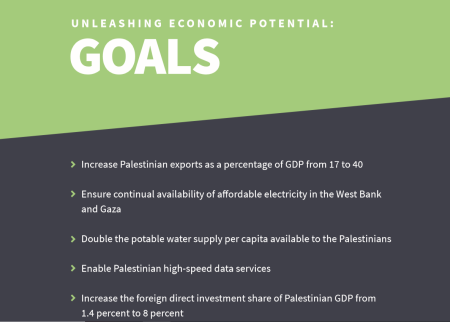
Small detail of goals in “Economic part” of DoC
The economic portion of the Doc is slightly similar to the Marshall Plan which was aimed to rebuild Western European economies after World War II. This part of DoC (more in Palestine: Peace & Prosperity Plan ) was billed as “a vision to empower the Palestinian people to build a prosperous and vibrant Palestinian society.” The plan calls for a $50 billion mix of grants, loans and private investments over ten years to develop a future Palestinian state’s infrastructure, telecommunications, tourism and health care industries. Jordan, Lebanon and Egypt, states that have absorbed Palestinian refugees for decades, would receive nearly half the funding.
Some critical remarks
In my opinion the DoC could be even better. From my point of view the map would be more clear if Israel would annex only some 200,000 Israelis who live in the 12 Jewish neighbourhoods of East Jerusalem and the second group of some 300,000 Israelis who live in the so called ‘settlement blocs,’ located west of the security barrier which are usually very close to the Green Line. The rest 90,000 settlers – less than 20 per cent of the entire population of those living beyond the Green Line – who live beyond the route of the security barrier, could be relocated inside barrier and future border.
There is a risk – according study by Commanders for Israel’s Security (CIS) – that the annexation might lead to the collapse of the Palestinian Authority and the absence of an alternative government authority will force Israel to seize control of Areas A and B and to impose upon them a Military Administration regime. The annexation of the entire West Bank will constitute the irreversible abandonment of the trend toward separation and the de facto adoption of a one-state outcome.
I think that the core problem is whether Israel is a democratic state including its Palestinian residents from disputed territories or a Jewish State separating Israeli citizens from most part of Palestinian residents in West Bank; Israel can be democratic only if all its citizens have equal human and political rights.
From my point of view Israel’s borders are defensible even if Israel annexes only 5-15% of West Bank and after Security Barrier has completed. I base this claim e.g. with following aspects:
- Israel has military and intelligence edge and I don’t have any doubts that it can keep this edge also in future,
- IDF, Mossad, Shin Bet etc can copy fast and flexible way to any new threads and challenges be they kite balloon or cyber attacks e.g. due first class ecosystem supporting new innovations,
- IDF is developing whole time both technic and strategic levels and probably it will have also enough financial resources to be updated based to its popular support in Israeli society; IDF is one of the most respected organisations in Israel.
If aspects mentioned above are valid it makes possible political decisions – negotiated or unilateral – like separation and relocating outposts. (More in Israel´s Eastern Border? )
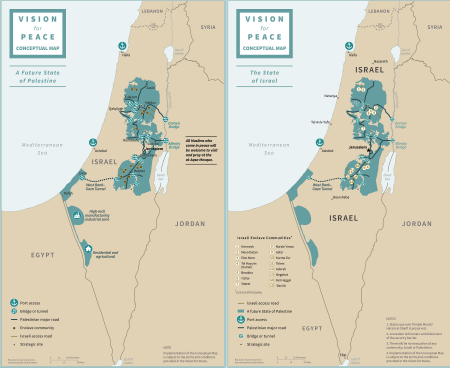
Two-States according Deal of Century. Source: The White House
The DoC contemplates the possibility, subject to agreement of the parties that the borders of Israel will be redrawn such that the Triangle Communities become part of the State of Palestine. The Triangle is an area southeast of Haifa, near the Palestinian city of Jenin, which includes 14 towns and villages where more than 260,000 Arab Israelis live. These communities, which largely self-identify as Palestinian, were originally designated to fall under Jordanian control during the negotiations of the Armistice Line of 1949, but ultimately were retained by Israel for military reasons that have since been mitigated.
Residents of those areas have protested against the idea that they may one day be redefined as living in a new Palestine state. I don’t understand why this kind of detail still is in final version of DoC; one reason why the Triangle is in DoC could be to win support from hawkish Yisrael Beytenu leader Avigdor Liberman who has long advocated for such adjustments in any peace deal with the Palestinians.
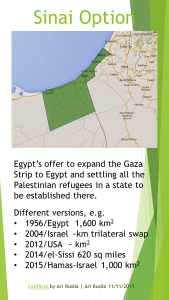
In my opinion implementing the sc Sinai Option in cooperation with Egypt would be much better solution to Egypt, Israel and Gazans. This option was last time in public 2014 when – according Middle East Monitor (MEMO) report [01 September 2014 ] – Egypt offered Palestinian Authority’s President Abbas a Palestinian state in Sinai. Egyptian President Abdel-Fattah el-Sissi offered Palestinian Authority 620 square miles of land adjacent to Gaza in exchange for relinquishing claims to 1967 borders for the purpose of establishing a Palestinian state. (More in Sinai Option again )
Is DoC politically realizable?
Every Time Palestinians Say ‘No,’ They Lose (Bret Stephens)
Comprehensive peace proposals were presented to Palestinian leadership three times in the past – once by the United Nations (1947) and twice by Israel (2000, 2008). All three times, Palestinian leadership rejected broad peace deals, while Israel said yes. Palestinian rejection – anchored in refusal to accept the right of Israel to exist as a Jewish state – remains the primary obstacle to peace. As Israel made major concessions for peace with Egypt and Jordan , so probably Israel will do the same with Palestinians based on DoC and possible negotiations with Palestinians.
Many ministers from Netanyahu’s Likud party as well as the Yamina alliance of right-wing parties are against the Trump plan, if it includes any mention of a Palestinian state. However in my opinion clear majority of center-right and center-left political parties support DoC so saying “yes” to a Palestinian state on what is likely to be some 80% of the West Bank, while also agreeing to a Palestinian capital on the northern and eastern outskirts of Jerusalem beyond the current security barrier.

Arab powers appear to be prioritizing close ties with the United States that are vital to countering Iran over traditional unswerving support for the Palestinians in their reaction to President Donald Trump’s Middle East peace plan. Despite Palestinians’ rejection of the plan and boycott of Trump over perceived pro-Israel bias, three Gulf Arab states – Oman, Bahrain and the UAE – attended the White House gathering in a sign of changing times. Saudi Arabia, Egypt, Qatar, and the UAE issued statements welcoming the Trump administration’s peace plan.
This time the U.S. initiative has a wide regional support and probably it will gain support also among Palestinian population as it indeed gives “a vision to empower the Palestinian people to build a prosperous and vibrant Palestinian society.” So from my point of view the plan, also its political part, has good change to be implemented also without acceptance from current Palestinian leadership.
Also The United States hopes that DoC will lead to direct negotiations between Israel and the Palestinians and then it will be up to Israeli and Palestinian leaders to take courageous and bold actions to end the political stalemate, resume negotiations on the basis of Doc, and make lasting peace and economic prosperity a reality.
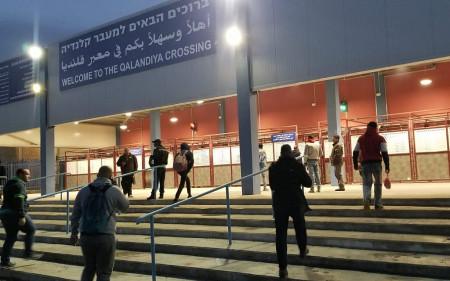
New high-tech Qalandiya Crossing: the process of examination and entry at the crossing has been shortened so that passing through requires only a few minutes as opposed to the hours it required in the past. Source: COGAT
My view
Every Time Palestinians Say ‘No,’ They Lose (Bret Stephens)
Israel and Palestinian Authority have negotiated two decades about solution based on Two-States, and now maybe more than ever one can claim that the roadmap towards it is the dead end. Instead the situation today is drifting towards One-State option, which is unwanted outcome for both parties. The outcome of the U.S. initiative may well be Two-States but the roadmap is new with regional and economy first approach and this in my opinion gives a better change for positive development and even solution this time.
Prior U.S. and international efforts to settle the more than 70-year Israeli-Palestinian conflict have focused on a process that would leave many of the most sensitive issues to negotiations between Israelis and Palestinians. The Trump plan veered from that by presenting a proposed final outcome. No prior conception of a peace settlement, moreover, has gone as far in articulating a plan to foster Palestinian civil and economic vitality.
I agree with President Trump that his Vision is the most serious, realistic, and detailed plan ever presented, one that could make Israelis, Palestinians, and the region safer and more prosperous. In my opinion even at minimum it creates updated framework for possible Israeli-Palestinian negotiation as well possible one-sided Israeli actions if negotiations don’t start. DoC is just the first step and provides the basis for historic progress toward peace. Anyway the best aspect with DoC in my opinion is that it simply mirrors the reality on the ground as it exists today in the West Bank and not high-flown ideas and utopies.
Some of my related articles:
Israel-Palestine Conflict: Regional Approach
“New” Idea: Connecting Gaza to Northern Sinai
Israeli-Palestinian Conflict: A Revised Hybrid Model as Solution
Palestinians Put Jordanian Option on the Table
Constructive Unilateralism (II) as Solution to Israeli-Palestinian Conflict
Herzog’s Plan: Security Barrier Around the Major Settlement Blocs of West Bank
Analysis: Resolving The Israeli-Palestinian Conflict
Peacemaking – a Holistic Approach
Appendix:
From deal to ”Quality peace”
“The only way to solve a conflict at any level of society is to sit down face to face and talk about it.” (John W. McDonald)
.
Deal of Century is exellent peace plan but does it sole the conflict is other question. From my point of view current peacemaking, peace-building or crisis management structures are not designed to cope today’s modern type of conflicts. In my opinion peacemaking is only secondary action by managing conflicts – a deeper holistic approach is needed to make more sustainable solutions. This approach can have an outcome which I call ”Quality peace”

More about holistic approach e.g :
Peacemaking – a Holistic Approach
Peacemaking – How about solving Conflicts too?
Civil Crisis Management: Filling the Gaps Between the Aims and on the Ground Effectiveness of a Mission
R2P vs Facades of Interventions
Multifaceted Intervention Practices
Quality Peace?

